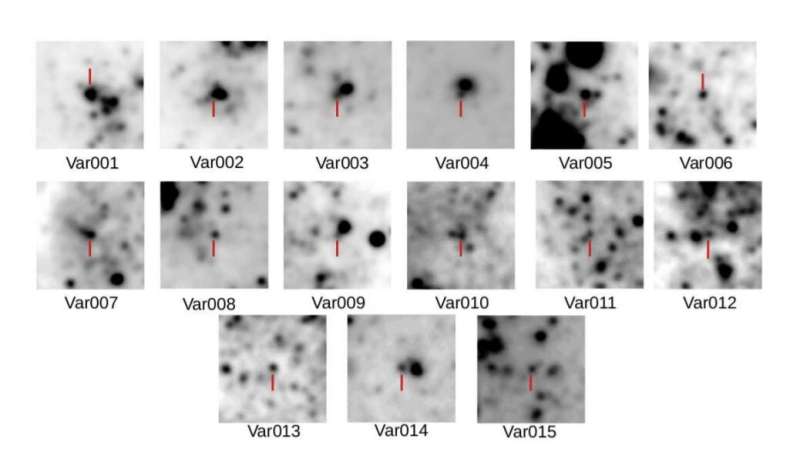August 9, 2021 report
Fifteen new variable stars detected in the galaxy NGC 247

Using the Gemini Observatory, astronomers have detected 15 new periodic and non-periodic variables in a nearby galaxy known as NGC 247. The finding, reported in a paper published July 29 on the arXiv pre-print repository, could improve our knowledge regarding stellar populations of this galaxy.
Variable stars could offer important hints into aspects of stellar evolution. They could also be helpful for better understanding the distance scale of the universe. Investigating variables in galaxies that sample a range of metallicities is of special interest for astronomers as such studies have the potential to yield constraints on stellar structure models.
At a distance of about 11.1 million light years, NGC 247 (also known as Caldwell 62) is an intermediate spiral galaxy, of SAB(s)d type, with a diameter of some 70,000 light years. NGC 247 is one of only a few late-type galaxies showcasing large-scale structural characteristics, suggesting tidal interactions within the recent past.
Given that so far, the variable star content of NGC 247 has not been thoroughly studied yet, a team of astronomers led by Tim Davidge of the Dominion Astrophysical Observatory in Canada, decided to investigate this. Using the Gemini Multi-Object Spectrograph (GMOS) on the Gemini South telescope and by analyzing archival images from other facilities, they have carried out a search for new variables in this galaxy.
"In the current paper we present the results of a search for variable stars in the southern disk of NGC 247. The primary dataset consists of g′ images recorded with the Gemini Multi-Object Spectrograph (GMOS) on Gemini South (GS) during a seven month period in 2008 and 2009," the researchers wrote in the paper.
All in all, the study identified 15 new periodic and non-periodic variable stars in NGC 247. The sample includes three Cepheid variables, four semi-regular variables, five variables with intrinsic visible/red brightnesses and colors similar to those of luminous blue variables (LBVs), and three fainter blue variables, one of which may be a non-eclipsing close binary system.
The newly found Cepheids have periods below 25 days. This is near the low end of those Cepheid variables already discovered in NGC 247. The astronomers noted that in general the Cepheids with periods between 20 and 30 days are seen over much of the NGC 247 disk.
As noted in the paper, eight new variables with blue colors have been identified by Davidge's team. However, they added that in order to discover their nature, spectroscopic and additional photometric studies are required. This could help to characterize the absorption and emission lines in the spectra of these stars, as well as the time scale and amplitude of their light variations.
The four semi-regular variable stars identified in the study are also interesting. Three of these have red colors, and are classified as SRbs—semi-regular variable giants of late spectral classes (M, C and S) with a poorly expressed periodicity. The fourth semi-regular variable has a g'–i' color that is indicative of an intermediate spectral-type and has been classified as type SRd—semi-regular variable giant or supergiant belonging to spectral classes F, G, K.
More information: T. J. Davidge, New Blue and Red Variable Stars in NGC 247, arXiv:2107.14354 [astro-ph.GA] arxiv.org/abs/2107.14354
© 2021 Science X Network




















